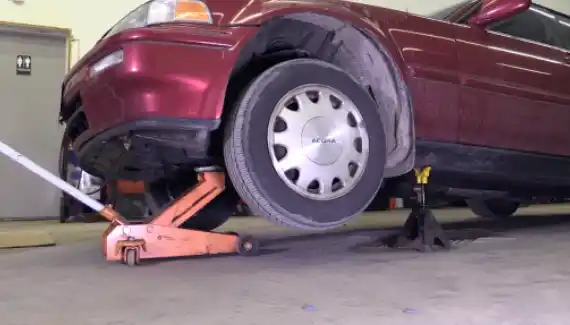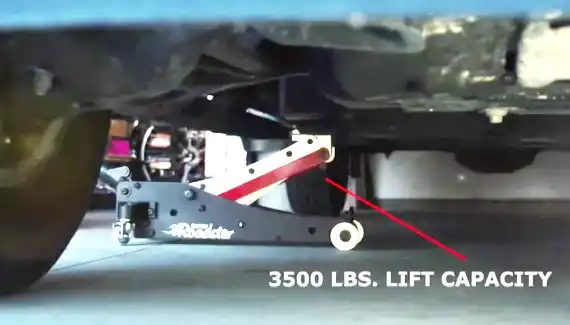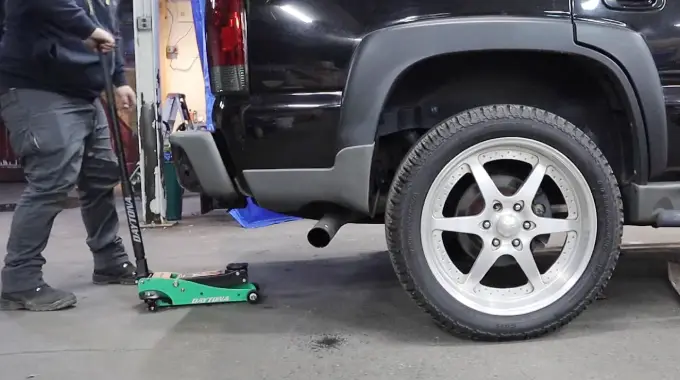Last Updated on April 12, 2023
The 1.5-ton floor jack is the dependable sidekick of any DIY mechanic’s garage. It helps you lift cars and change tires. But just how powerful can one be? Rest assured. Its hefty capacity allows it to lift up even a full-sized sedan car with minimal effort.
1.5-ton jack lifts can provide the perfect lifting solution for cars below 3,000 pounds. So you don’t have to strain when getting your car off the ground.
You can confidently lift your car following the steps correctly. From preparing the surface, locating the correct lifting points, positioning the floor jack under the car, lifting and stabilizing it with jack stands, carefully monitoring its position, and adjusting as needed.
We’ll go over how to use this powerful tool, including what type of surface it needs to be operated on and what lifting points are required for safe lifting.
How Can You Lift A Car With A 1.5 Ton Floor Jack: Easy Steps Guide

Changing a flat tire or general maintenance can often require lifting your car with caution and precision. A 1.5-ton floor jack serves as a perfect tool to accomplish this feat. Here’s an expert guide on safely lifting your car for optimal results.
01. Gathering Necessary Tools & Materials
Gather the necessary tools before beginning work, such as wrenches and screwdrivers. Confirm safety equipment, such as stands or blocks, is in place. Ensure protective eyewear is prepared. Check the weight capacity of the jack before use.
02. Preparing to Lift the Car with a 1.5 Ton Floor Jack
Before lifting your car, ensure that you have the correct type of jack for your car. This is important because different cars will require different jacks, and failure to get the right type could lead to severe damage.
For a 1.5-ton floor jack, you should look for a heavy-duty hydraulic jack that can easily lift up to 3,000 pounds. You should ensure that the floor jack has a wide base to support your car without tipping over when it’s lifted up.
03. Choose A Flat, Level Surface To Work On
Ensure a flat and level surface before using a floor jack. Concrete or asphalt driveways or garage floors are the best surfaces to use. If these are unavailable, then a flat piece of wood or plywood can be used as an alternative, though slippage is more likely on this type of surface.
04. Prepare The Floor Jack For Use
Inspect connections from top-to-bottom for leaks. Test each side of the handle to ensure no bending occurs. Visually inspect components, paying special attention to hoses and pump handles. Ensure no signs of damage or wear are present before use.
05. Identify The Correct Lifting Points On The Car
Identify and understand the appropriate lifting points on the car by consulting a manual or diagram for the make and model. Inspect under the car if necessary to determine exact spots. For solid contact with a floor jack, ensure lifting points are free of detritus.
06. Position The Floor Jack Under The Jack Point Of The Car

Securely place a 1.5-ton floor jack beneath the lift point and ensure it is level. Pump handle to lift off other ends. Take extra care when carrying out these steps to avoid any incidents. Maintain the stability of the car and ensure safety for you and your car.
07. Pump The Handle Of The Floor Jack To Lift Up Your Car
Pump up and down until the car is lifted 10-15 cm from the resting position, checking the manual for specific measurements. Monitor any jerky movements or vibrations; stop if there is an issue with either jack or lift point and double-check.
08. Monitor The Position Of Your Car And Adjust Jack Level As Needed
Alternating between pumping up and down on the handle, observe any irregularities in how it behaves. Lower back down if components are misaligned before attempting again. Adjust either component accordingly if necessary. Once stable, proceed to the next step.
09. Select and Position the Correct Jack Stands
Select quality jack stands sized appropriately for your car, truck, or SUV. Position the jacks correctly on the sturdy contact points of your car.
Align both sides level with one another and ensure they are far enough away from each other. Slowly lower the floor jack onto each side until it contacts its respective point on either side of the car.
10. Securing With Jack Stands
Reach safe height via a 1.5-ton floor jack. Secure with reliable stands placed below jacking points. Lock in place vertically and horizontally for extra stability. Consult knowledgeable mechanics on the model of the car to use. Seek guidance for home repairs involving large loads.
11. Lower The Car Onto The Jack Stands
Begin lowering the car on jack stands slowly and evenly, depressing the handle on the floor jack.
Alternately use one side of the floor jack to raise all four wheels off the ground simultaneously. Lower each pair of corresponding jack stands evenly, checking periodically between adjustments.
12. Re-ensure The Car Is Secure And Stable

Re-check four corners are secured properly. Ensure two pairs of jacks are holding the car off the ground. No movement among either pair to prevent an unstable working environment. Safety first when tooling around or making adjustments below the deck surface level.
13. Remove The Jack Stands From The Car
Ensure the floor jack is secure and locked in position. Gently lift each stand one at a time until it clears from underneath the car. Take care and caution when removing jack stands to avoid car collapse or injury.
14. Double-Check the Attachment of the Floor Jack When Re-positioned To Lower Your Car
Inspect wheel and axle assemblies for damage or wear from the jack. Ensure all nuts and bolts are tightened securely. Double-check the undercarriage for leaks or damage. Carefully remove the floor jack after all steps are complete.
15. Slowly And Carefully Lower The Car Using The Floor Jack
You should ensure that the car can rest securely on a flat surface where it can rest comfortably. The floor jack should be engaged with the frame of the car before the car can be lowered. The object should be lowered slowly, feeling resistance as it reaches the ground.
Why Do 1.5-Ton Floor Jacks Sometimes Fail When Lifting a Car?
Car lifts can be tricky. Ensure you know what to look out for, or else your ride won’t get raised. Familiarize yourself with potential problems that may interfere when lifting up your car before tackling the job.
Reason 01. Improper Positioning
Improper positioning of the floor jack can also cause failure. Placing a floor jack on an uneven surface or soft ground, such as dirt or gravel, can cause wobbling and lead to accidents when lifting heavier cars.
Incorrect placement under the car can damage components like exhaust systems, making them brittle and more prone to damage when weights are shifted during use.
Reason 02. Incorrect Handle Height Setting

While many people may think that all floor jacks are made alike and function as such, this isn’t always true. Different models may have different handle height settings, which means they will only work perfectly if they are set at their correct height before use.
Incorrect floor jack setup when lifting a car can create an unsafe environment, as the center of gravity is too high, and pressure distribution becomes uneven. This destabilizes both the car being lifted and the support mechanism beneath it.
Reason 03. Leaking Hydraulic Fluid
Hydraulic fluid in 1.5-ton floor jacks should be checked regularly for leaks to avoid failure when attempting heavy lifts. Damaged parts should be replaced promptly to avoid preventable failures.
Routine and timely maintenance checks are important for avoiding issues with the jacks’ ability to lift heavy weights safely and efficiently.
Reason 04. Bent or Cracked Components
An incorrect amount of force applied to handlebars can cause 1.5 Ton Floor Jacks to fail while lifting cars. An overextended armature bar extending outward instead of inward leads to strains on the components underneath, which can cause fractures near welded connections.
Higher temperatures and air rusting around metallic surfaces can worsen the situation and lead to machinery breakdown. Resolving this issue requires professional mechanics specializing in the field.
What Happens If You Overload a 1.5-Ton Jack?
The overweight of a 1.5-ton jack shouldn’t be something to take lightly; it can cause major headaches like personal injuries, car damage voided warranties, and even compromise safety. Let’s review some of the potential consequences:
01. Jack Failure
An overload on a 1.5-ton jack might cause it to fail and cause the car to collapse. There’s a chance the car will get damaged, and someone nearby could get hurt.
02. Personal Injury
You can also get hurt when overloading a 1.5-ton jack. Any nearby people can be struck by falling debris or trapped by the car’s weight if the car collapses suddenly.
03. Damage to Car
A 1.5-ton jack that is overloaded is likely to damage the car. Under heavy loads, the jack can bend or break, causing damage to the car’s undercarriage or body.
04. Risk of Fire
A 1.5-ton jack can also catch fire if it’s overloaded. Fuel or oil leaks from the jack can ignite and cause a fire if there’s too much weight on it.
05. Voided Warranty
You can void the warranty provided by a 1.5-ton jack if you overload it. You could end up paying extra for repairs or replacements if the jack fails due to overloading.
06. Unreliable Lifting
When a 1.5-ton jack is overloaded, it can lift the car unevenly or unpredictably, making maintenance or repairs impossible. The car could also slip off the jack and cause more damage.
07. Inaccurate Weight Measurement
It’s also possible to get inaccurate measurements by overloading a 1.5-ton floor jack. Incorrect weight measurements can lead to imbalanced lifting or inaccurate diagnosis if you overload the jack.
08. Increased Maintenance Costs
When you overfill a 1.5-ton jack, the car will cost more. If the jack gets damaged or worn from the car’s weight, it must be repaired or replaced. This can also mean more frequent maintenance and inspections to ensure the jack is safe and reliable.
09. Safety Risks
When you overstuff a 1.5-ton jack, you’re risking the safety of the car you’re lifting and everyone around you. A jack used beyond its weight capacity can cause accidents, injuries, or even deaths, which can have long-term effects.
1.5 Ton Floor Jack: A Safe and Reliable Lifting Option for Your Car

Trying to lift up your car can feel like a real challenge, but with the right gear and good technique, it’s doable. Ensure you create an area safe for yourself and your car, then you’re ready to go.
Don’t be caught unprepared when checking your car’s safety features. Preparation is key. Have all of the necessary tools ready in advance. Not only that, but double-check that each jack stand is secure and leveled for ultimate peace of mind.
Following these steps correctly should have you safely parked in no time. Use extreme caution when tinkering underneath your car, and as an added bonus, you can now inspect or even change the oil easily.
This blog post points you in the right direction, so repairing your next project doesn’t have to be daunting. Plus, more great resources are available if you still have trouble mastering all those tools tucked away in your garage.
